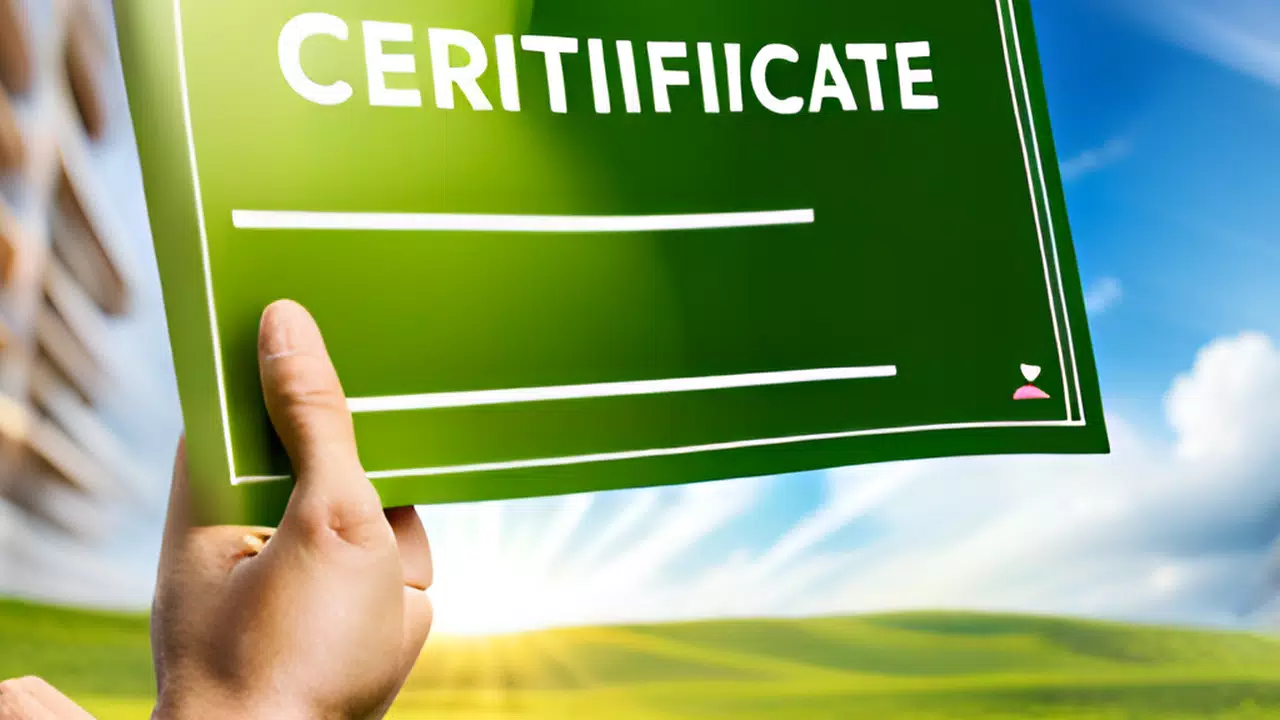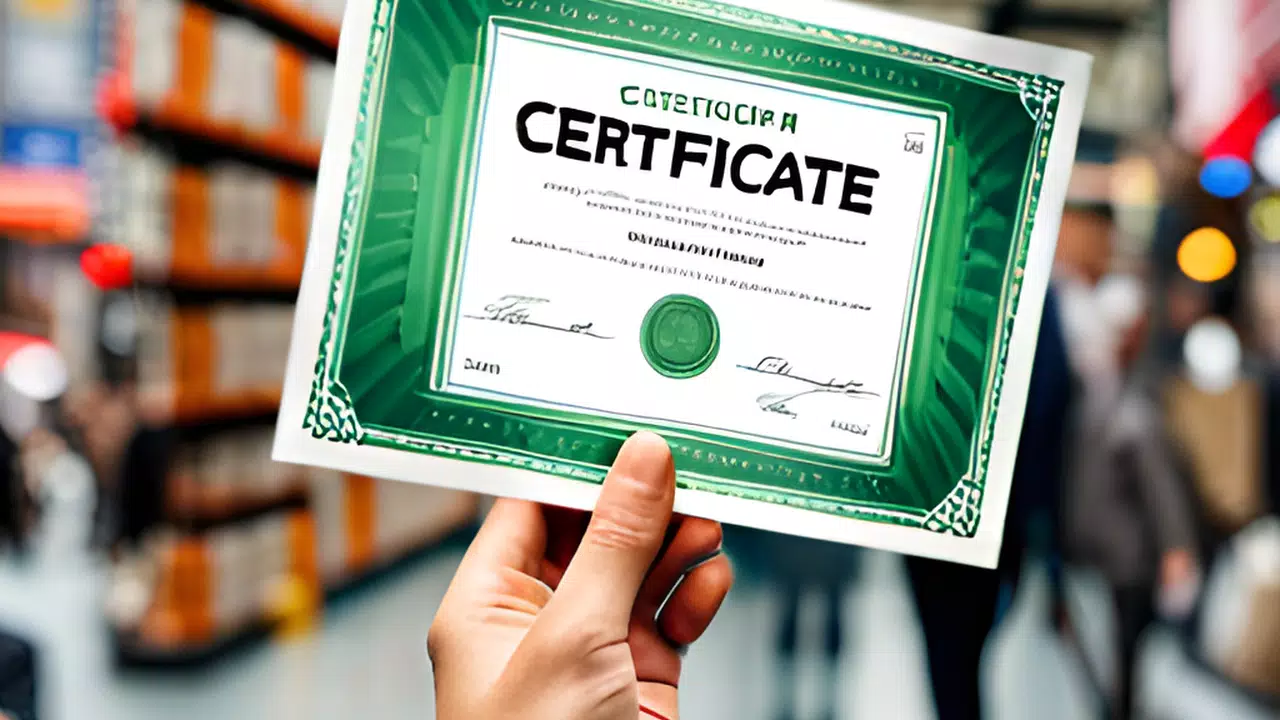
What are Green Certificates?
Green certificates play a pivotal role in fostering renewable energy sources by offering financial incentives to producers. This system is intended to mitigate greenhouse gas emissions and stimulate sustainable energy generation.
What are Green Certificates?
Green certificates represent proof of 1MWh of electricity produced from renewable sources, such as wind, solar or hydropower. These certificates can be traded on the market and they provide an additional source of revenue for producers of renewable energy. The demand for green certificates is created by energy suppliers who are required to purchase a certain number of them annually. This system helps to reduce the costs of producing renewable energy and therefore encourages more sustainable energy production.
The Trading System
Green certificates are a component of a trading system designed to encourage the production of renewable energy. The price of these certificates fluctuates within a range set by the government and is influenced by market forces of supply and demand. This trading system contributes to the stability of the renewable energy market by providing a predictable revenue stream for producers of renewable energy.
Romania's Example
Romania is a prime example of a country that has effectively implemented the green certificate system to encourage the adoption of renewable energy sources. Within Romania's framework, electricity suppliers are mandated to procure a specified number of green certificates annually, contingent on the volume of electricity they provide to their consumers. The price of these green certificates has been maintained at a fixed rate for several years, and this approach has proven successful in fostering the utilization of renewable energy sources nationwide.
The importance of green certificates lies in their ability to support the transition towards more sustainable energy production practices. By providing financial incentives for producers of renewable energy, this system helps create a more stable and predictable market for renewable energy. Green certificates also provide an opportunity for individuals and businesses to take part in promoting sustainable practices by purchasing electricity that is certified as coming from renewable sources. As more countries implement this system, it is likely that the cost of renewable energy production will continue to decrease, making it a more viable option for meeting our energy needs in the future.

How Green Certificates Work in Practice
The green certificate system operates through mandatory quotas and trading mechanisms, aiming to balance the interests of producers and consumers while promoting the development of renewable energy. Green certificates represent proof that a certain amount of electricity was generated from renewable sources and are a way for electricity suppliers to comply with renewable energy quotas set by governments. In this article, we will explore the key points of how green certificates work in practice and why this system is an essential part of promoting renewable energy.
Producers receive green certificates for every 1 MWh of renewable energy generated.
For every 1 MWh of electricity generated from renewable sources, producers receive a green certificate. This is designed to offset the additional costs associated with developing and operating renewable energy projects. By receiving additional revenue for each green certificate produced, renewable energy projects can become financially sustainable, while also promoting the development of cleaner technologies.
According to a study from Gain without Pain, in Ukraine, the proposed system of tradable green certificates would help increase the share of electricity from renewable energy sources in the energy mix. The study showed that increasing the annual cap for green electricity consumption by 1% will only raise the electricity tariff by 3%, which is not a significant financial burden for consumers.
Electricity suppliers must purchase a set number of green certificates each year
Electricity suppliers must purchase a set number of green certificates each year to comply with government quotas for renewable energy. The number of certificates they must purchase is proportional to their market share of total electricity sales. By purchasing green certificates on the centralized spot market, electricity suppliers can demonstrate compliance with government quotas while also promoting the development of renewable energy.
The effectiveness of green certificates in promoting renewable energy has been extensively studied across various countries. According to Core.ac.uk, green electricity certificates were found to be an effective mechanism for promoting renewable energy in the United Kingdom in comparison to other countries.
The price of green certificates covers the difference between renewable energy production costs and market prices.
The price of green certificates represents the difference between the production costs of renewable energy and the market price of electricity. By transferring this price differential to electricity suppliers, producers are able to recover the additional costs associated with renewable energy development. The system ensures that producers and suppliers can operate in a financially sustainable manner, while also promoting the development of cleaner energy sources.
Minimum and maximum prices are set to protect both producers and consumers. According to a study from Core.ac.uk, green tradable certificates were found to be more effective in promoting renewable energy than feed-in tariffs. The study showed that green tradable certificates ensured more stable system development with less volatility in feed-in tariff rates.
Trading occurs on anonymous centralized spot markets, ensuring transparency
Trading of green certificates occurs on anonymous centralized spot markets, which ensures transparency. This system ensures that prices are set through supply and demand dynamics rather than manipulation or insider trading. This promotes confidence in the overall system while also ensuring that both producers and suppliers are able to operate efficiently.
In conclusion, the green certificate system is an essential part of promoting renewable energy. By offsetting the additional costs associated with renewable energy development, electricity producers can operate financially sustainably while also encouraging the advancement of cleaner technologies. The mandatory quotas and trading mechanisms associated with green certificates motivate energy suppliers to invest in renewable sources while adhering to government quotas. Consumers benefit from increased transparency and confidence in the system as a whole. Overall, the green certificate system fosters the adoption of cleaner and more sustainable energy sources, contributing to a brighter future for everyone.

Steps to Obtain Green Certificates in Romania
Companies interested in obtaining green certificates in Romania must follow a series of steps, from securing land to registering with relevant authorities. These steps ensure that projects meet necessary requirements and contribute to the country's renewable energy goals.
1. Secure Land for Renewable Energy Projects
One of the initial steps to obtaining green certificates in Romania is securing land for the project. The land must be either owned or rented for a minimum of 20 years, and it is recommended to be in areas with high wind or solar potential. According to the Romanian National Energy Regulatory Authority (ANRE), a minimum distance from nearby buildings and environmentally sensitive areas must be maintained. This is necessary to prevent any negative impact on wildlife, habitats, or nearby communities.
2. Obtain an Urban Planning Certificate for Project Development
After securing land, companies must apply for an urban planning certificate from the city hall of the respective locality. This certificate confirms that the renewable energy project is in line with urban planning policies and regulations in Romania. This requirement also helps ensure compliance with Romanian laws and regulations related to environmental protection and other requirements.
3. Provide Various Documentation as per Urban Planning Certificate Requirements
Once companies obtain an urban planning certificate, they must provide various documentation as per the requirements indicated in the certificate. These requirements may include a technical project supporting documents, proof of land ownership or rental agreement, environmental impact assessments, etc.
4. Obtain Construction Authorizations for Both Power Plant and Connecting Lines
Companies must obtain construction authorizations from the relevant authorities to commence building the power plant and connecting lines. The authorizations are processed by ANRE and can take several months. This process also involves obtaining building permits and environmental authorizations.
5. Obtain Environmental Approvals and Permits Before Construction Begins
Environmental approvals and permits must be obtained before construction commences, as this helps ensure that the renewable energy project does not harm the environment. These approvals and permits are typically granted by reputable environmental authorities and organizations after an environmental impact evaluation is conducted and all necessary mitigation measures are implemented.
6. Technical Connection Approval from the Network Operator Is Required
Technical connection approval from the network operator is required to ensure the renewable energy project can connect to the national electricity grid. This process involves applying through the ANRE and may take several months to complete.
7. Register with ANRE, Transelectrica, and OPCOM SA to Obtain Green Certificates
Finally, companies must register with ANRE, Transelectrica, and OPCOM SA to obtain green certificates. These certificates are issued monthly in Romania and confirm that a certain amount of electricity was generated from renewable energy sources. Companies can sell these certificates on the open market or use them to meet renewable energy quotas.
In conclusion, Romania has established a well-defined process for companies seeking to obtain green certificates. This process involves various government entities, environmental authorities, and institutions. It ensures that renewable energy projects are environmentally sustainable, comply with urban planning policies, and contribute to Romania's renewable energy targets. By following these steps, companies can contribute to a more sustainable future while enjoying incentives such as green certificates.

Challenges and Opportunities in the Green Certificate System
While the green certificate system offers various benefits for renewable energy development, it also presents certain challenges. Understanding these aspects helps stakeholders make informed decisions and improve the system's effectiveness.
The green certificate system incentivizes renewable energy production and reduces emissions
Green certificates are a market-based instrument that incentivizes the production and use of renewable energy sources. These certificates represent proof that a certain amount of renewable energy has been generated and can be traded separately from the energy itself. By creating market demand for renewable energy, green certificates help reduce greenhouse gas emissions and promote sustainable energy development. According to core.ac.uk, both feed-in tariffs and tradable green certificates have been used in Spain to encourage the adoption of renewable energy sources.
However, the process of obtaining green certificates can be complex and time-consuming.
Producers of renewable energy must undergo a certification process to obtain green certificates. This process can be complex, time-consuming, and costly, hindering smaller businesses from participating in the market. Moreover, green certificate schemes vary in their administration and design, making it difficult for producers to navigate the system. For example, core.ac.uk highlights that the UK's Renewable Obligation Certificate scheme has faced criticism for being overly complex.
The pricing mechanism may not always provide sufficient support for producers or protection for consumers.
Green certificate prices are determined by the market's supply and demand dynamics, which may not always reflect the true costs of renewable energy production. In some cases, prices have been criticized for being too low to adequately support producers or too high to provide protection for consumers. Additionally, due to the varying operations of different schemes, there is no uniform pricing mechanism across different regions. According to core.ac.uk, the high green certificate prices in Denmark and Germany can be attributed to their early adoption of renewable energy sources.
Balancing the interests of different stakeholders remains a challenge
The green certificate system involves multiple stakeholders, including producers, consumers, regulators, and investors. Balancing their interests remains a challenge due to competing objectives among different groups. For instance, producers may aim for higher certificate prices to increase revenue, while consumers typically prefer lower prices to reduce energy costs. To tackle these challenges, some schemes have introduced price floors and ceilings to maintain stable prices and protect consumers. Core.ac.uk emphasizes that the decision-making process for green certificates should consider all involved stakeholders.
Continuous improvement and adaptation of the system are needed to maximize its potential.
The green certificate system has undergone significant evolution since its introduction in the 1990s. As the renewable energy market expands and new technologies emerge, the system must continuously adapt to realize its full potential. This entails enhancing certification processes, establishing uniform pricing mechanisms, and ensuring that the interests of stakeholders are considered. According to core.ac.uk, tradable green certificates can effectively promote renewable energy development when properly implemented.
In conclusion, while the green certificate system offers potential benefits for renewable energy development and emissions reduction, it also presents certain challenges that need to be addressed. By understanding these challenges and continuously improving the system's design, stakeholders can work together to achieve a more sustainable and effective energy market.

The Future of Green Certificates and Renewable Energy
As global efforts to combat climate change intensify, the role of green certificates and other support mechanisms for renewable energy will become increasingly important. By understanding their workings and potential impact, stakeholders can contribute to a more sustainable future.
Green certificates play a vital role in promoting renewable energy sources worldwide
Green certificates, also known as Renewable Energy Certificates (RECs), are a market-based tool that encourages the generation of renewable electricity. According to Renewable Energy World, "RECs provide a way for existing clean energy projects to generate extra revenue - improving their viability - and an efficient method for entities to achieve specific renewable targets." RECs function by monitoring the production of renewable energy and issuing certificates to the owners of these renewable energy initiatives. These certificates can then be sold to entities aiming to counteract their carbon impact. Green certificates are essential in fostering the adoption of renewable energy sources globally by assisting in overcoming challenges such as high production costs and technological constraints.
They have the potential to significantly reduce greenhouse gas emissions
As more entities seek to reduce their carbon footprint, green certificates have the potential to significantly reduce greenhouse gas emissions. According to Green Power Market Development Group, "One megawatt-hour (MWh) of renewable energy generation produces one REC, which represents the environmental attributes or benefits associated with electricity generated from a renewable resource." By purchasing RECs, entities can claim that they are offsetting their carbon footprint by supporting renewable energy projects. This reduces the demand for energy from non-renewable sources, leading to reductions in greenhouse gas emissions. In addition, green certificates can incentivize the investment in renewable energy projects, accelerating their development and deployment.
As renewable energy technologies advance, the need for support mechanisms like green certificates may evolve.
As renewable energy technologies advance and the cost of producing renewable energy decreases, the need for support mechanisms like green certificates may evolve. According to The Energy Collective, "The timing of the phase-out of renewable energy support can influence the level of economic, social, and environmental benefits that can be reaped." As renewable energy becomes more cost-competitive, support mechanisms like green certificates may no longer be necessary. Instead, policies that encourage investment in early-stage and emerging renewable energy technologies may be more effective. However, it is important to note that the timing of the phase-out of green certificates must be carefully considered to avoid harming existing renewable energy projects.
International cooperation and policy developments will shape the future of green certificates
International cooperation and policy developments will play a pivotal role in shaping the future of green certificates. According to MDPI, "International cooperation is paramount in expediting the transition to a low-carbon economy and in attaining global climate goals." International policies like the Paris Agreement offer a framework for countries to unite in their efforts to reduce greenhouse gas emissions. The future of green certificates will be influenced by policies that prioritize clean energy and facilitate its implementation on a global scale.
Stakeholders must stay informed and adapt to changes in the renewable energy landscape.
As the renewable energy landscape continues to evolve, stakeholders must stay informed and adapt accordingly. This includes monitoring policy developments, technological advancements, and market trends. According to Forbes, "Carbon-conscious companies must adapt by accelerating their own transformation into a low-carbon company, or by investing in offset mechanisms such as renewable energy certificates." By staying informed and investing in renewable energy projects, stakeholders can contribute to a more sustainable future.
In conclusion, green certificates play a pivotal role in encouraging the adoption of renewable energy sources globally and hold the potential to diminish greenhouse gas emissions considerably. As renewable energy technologies progress, the necessity for support mechanisms, including green certificates, may undergo transformation. The future of green certificates will be influenced by international collaboration and policy innovations, necessitating stakeholders to remain abreast of developments and adjust to the evolving landscape of renewable energy. By grasping the impact of green certificates and other support structures for renewable energy, stakeholders can actively contribute to a more sustainable tomorrow.
